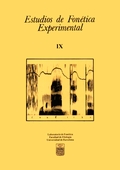Estudio acústico de las consonantes nasales del español
Abstract
The aim of this study is the acoustical description of the nasal consonants in contact with vowels using known techniques. The corpus consistes of the speech of 18 persons (9 males and 9 females), each of which read 15 sentences in which appeared the 15 combinations of the three Spanish nasal consonants with the five Spanish vowels, with the same vowel before and after the nasal consonant. In one case, the following parameters were obtained: formant frequency and bandwidth, formant transitions, and duration. Alternative studies for distinguishing nasals applied Stevens and Blumstein's (1979) method, based on the overall shape of the LPC spectrum, and also Kurowski and Blumstein's (1987) proposal, based on energy relationships in two frequency ranges of the LPC spectrums before and after the transition. Our study concludes that the palatal nasal [ɲ] is easily distinguished by the formant transitions, but no technique consistently separates the bilabial nasal from the alveolar one.
Downloads
Published
How to Cite
Issue
Section
License

This work is licensed under a Creative Commons Attribution-NonCommercial-NoDerivatives 4.0 International License.
All articles published online by Estudios de Fonética Experimental are licensed under Creative Commons Attribution-NonCommercial-NoDerivs 4.0 International (CC BY-NC-ND 4.0 DEED), unless otherwise noted. Estudios de Fonética Experimental is an open access journal. Estudios de Fonética Experimental is hosted by RCUB (Revistes Científiques de la Universitat de Barcelona), powered by Open Journal Systems (OJS) software. The copyright is not transferred to the journal: authors hold the copyright and publishing rights without restrictions. The author is free to use and distribute pre and post-prints versions of his/her article. However, preprint versions are regarded as a work-in-progress version used as internal communication with the authors, and we prefer to share postprint versions.




